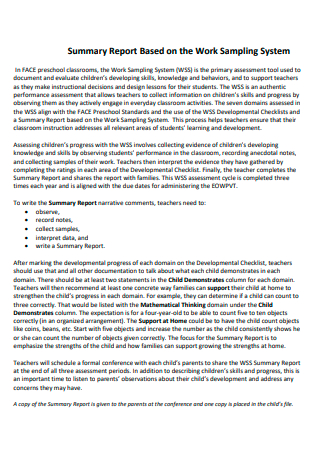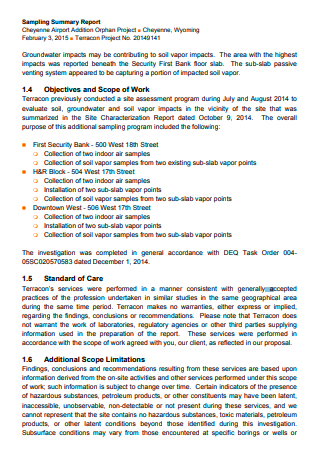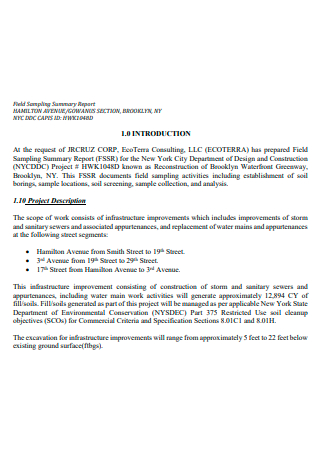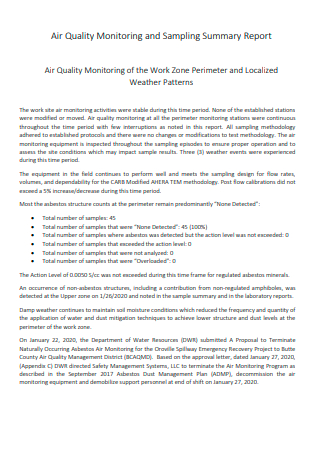3+ Sample Work Sampling Summary Report
FREE Work Sampling Summary Report s to Download
3+ Sample Work Sampling Summary Report
What Is a Work Sampling Summary Report?
Benefits of Work Performance
Tips for Requesting Samples
How to Write a Report
FAQs
What is work sampling for employee selection?
What is work sample observation?
What is a Good Work report?
What Is a Work Sampling Summary Report?
A work sampling summary report is used to record and monitor machine utilization and work performance via direct observation. This document helps determine the frequency of occurrence of specific activities via random observation and statistical analysis. Moreover, it is beneficial for both established and new businesses. Aside from that, it is also helpful for any other student assessment project in education.
Benefits of Work Performance
According to Tech Funnel, employees who are rewarded for their accomplishments are 50% more likely to be engaged, and 68% of employees will exert more effort if they are recognized and appreciated. These data are strong enough to motivate businesses to devise efficient methods of rewarding staff for improving business outcomes. Performance management is a crucial tool that enables individuals to perform at their highest level while providing employers with a wealth of information. This information can then assist them in making informed judgments. Although performance management is not regulated by law or any other regulatory body, its use is increasing as more firms recognize the benefits of a comprehensive performance management system. Here are some of its benefits if you’re interested.
Tips for Requesting Samples
Prospective employees can demonstrate their competence to perform essential job duties through samples. They allow candidates to demonstrate their practical abilities and demonstrate that they are valuable team members. By responding to a request for a sample with effort and originality, you can distinguish yourself from other candidates and demonstrate your abilities. A reasonable request for samples can facilitate the selection of an applicant for a position. If you are forming a team at work, you can request samples from possible team members by following these guidelines:
1. Understand the Function
Before requesting a work sample, check the job description and confirm that you know what you’re looking for in a candidate. Create a list of the requirements and consider the talents candidates must possess to be successful in the role. Assess how previous team members performed in the role and determine if there are opportunities for improvement. Consider your budget and decide if you can train new team members to execute challenging jobs.
2. Determine Guidelines
Consider the essential job criteria and how a candidate could demonstrate their ability to perform. Choose an example to submit that is relevant to the position’s requirements. If a position requires much writing, you may request a brief essay. If hiring for a more senior role, you could request that candidates provide examples of their work. Consider how you give the candidates opportunities to demonstrate their originality and innovation.
3. Specify Evaluation Criteria
Ensure that you have objective evaluation criteria for potential samples. Determine what you want to see in a completed sample and establish criteria for grading each component. Construct a procedure that helps you to avoid bias while evaluating completed work. Give more weight to the crucial features of the sample and be tolerant when inexperienced candidates make minor mistakes. In bringing a candidate onto your team, observe their performance in their new capacity and evaluate whether the sample accurately reflected their skills. Use this information to design future sample requests.
4. Provide Explicit Directions
Talk with prospects and verify that they comprehend what you’re requesting in your request. Give the directions for the example of work as clearly as possible, and be accessible to answer any queries. If candidates are aware of your expectations and have access to clear evaluation criteria, they may concentrate on submitting effective samples. Ensure that samples are manageable and transparent, as this could dissuade applicants from continuing. Provide applicants sufficient time to perform the required tasks so they are not rushed and can effectively exhibit their skills.
How to Write a Report
A report is a nonfictional account that describes or summarizes the facts of a specific event, topic, or issue. Those new to the topic should be able to learn what they need to know from a decent report. Reports simplify getting someone up to speed on an issue, but creating one is everything from simple. So let’s go into the specifics of report writing. Follow the seven stages below to go from an idea to a finished report.
1. Choose a Subject Based on the Assignment
Before you begin writing your report, you must select a topic. Frequently, the issue is assigned to you, as is the case with most commercial reports, or is predetermined by the nature of your work, as is the case with scientific reports. In that case, you can skip this step and continue. If you are responsible for selecting your topic, as with many academic papers, this is one of the most crucial parts of the entire writing process. Don’t forget the assignment’s directions, especially the length, so keep these in mind when deciding.
2. Conduct Research
In commercial and scientific reports, the research is typically your own or provided by the company; nonetheless, there is still a significant amount of searching for other sources. Unless compelled to use class materials, you are on your own for research when writing academic papers. This is one of the reasons why choosing the appropriate topic is so important; you will only get very far if there is a preliminary study on the topic you choose. The goal is to seek only credible sources, such as official documents, other reports, research paper proposal, case studies, and books by respectable authors. Please feel free to utilize research cited in comparable studies. Search engines provide access to a wealth of information, but a fast trip to the library might be helpful in a pinch.
3. Write a Thesis Statement
Before proceeding, compose a thesis statement to assist you in conceptualizing the report’s central idea. Similar to a paragraph’s topic sentence, the thesis statement outlines the central argument of your work, in this case, the report. Once you’ve gathered sufficient research, you should observe trends and patterns in the data. This is your thesis statement if these patterns suggest or contribute to a larger, overarching argument. For instance, if you were writing a report on the earnings of fast-food workers, your thesis statement could be: “After years of stagnation, wages are no longer sufficient.” The remainder of your report will provide adequate proof and support for your thesis. It’s a good idea to include your thesis statement in both the executive summary and the introduction of your report. However, it would help if you still determined it early so you can go in the right direction when you create your outline.
4. Prepare an Outline
For all kinds of writing, it’s best to outline, but it’s beneficial for reports, which are all about organization. Headings and subheadings are often used to divide reports into sections. A good outline will help you stay on track while writing so you can catch everything. It would be best to start thinking about your outline when you see patterns and trends in your research. If you can’t feel what to say, list the main points, details, and evidence you want to discuss. Check to see if you can put them into broad and specific groups that you can use as headings and subheadings.
5. Write a Rough Draft
Writing the rough draft or initial draft is typically the most time-consuming stage. You take all the research information and put it into words here. To prevent becoming overwhelmed, follow your outline step by step to ensure nothing is omitted by accident. The most important rule for writing a rough draft is not to be scared to make mistakes. Expecting your initial draft to be flawless adds significant strain. Instead, write in a natural and relaxed manner and address specific elements such as word choice and error correction later. In any case, this is what the last two stages are for.
6. Revise and Edit Your Report
Once the rough draft is complete, it is time to go back and correct the errors you missed the first time. We advise proofreading your report of severe errors, such as omitted or rearranged entire sentences and paragraphs. Occasionally, you will discover that your statistics could be more consistent or that you need to pay more attention to a crucial piece of evidence. Now is the moment to correct any “big picture” errors and rework any lengthy portions if necessary. If you are inexperienced with what to look for when editing, you can read some tutorials for more advanced suggestions on self-editing.
7. Proofread and Examine for Errors
Lastly, you should review your report to optimize your phrasing and check for grammar and spelling errors. In the previous phase, you checked for “big picture” errors, but in this step, you seek for specific, even minute errors. Writing help will identify these errors for you. Like Grammarly’s free edition highlights misspellings and grammatical errors as you type and provides ideas for improving your work with a single click.
FAQs
What is work sampling for employee selection?
Work sample examinations require applicants to do jobs or activities that resemble those performed by workers. For instance, candidates for the post of administrative assistant may be requested to transcribe an internal document using a word processor or file a stack of paperwork accurately.
What is work sample observation?
Original samples of children’s work provide robust evidence that can be utilized to determine the child’s cognitive and creative development. As you see a child’s collection of work examples throughout time, you can observe the distance each child’s learning and growth have traveled.
What is a Good Work report?
A good daily progress report will include a concise summary of your work, what you plan to do next, and the project’s status. Viewing it as a response to potential questions regarding your project is better.
The work sampling summary report is essential for comprehending fundamental changes and other inferences. It assists businesses in determining the feedback evaluation of their equipment and aids pupils’ education. If you want to compose a similar report, please read this article.




